Standard Chartered Bundle
How Does Standard Chartered Navigate the Global Banking Battlefield?
In the ever-shifting world of international finance, understanding the Standard Chartered SWOT Analysis is crucial. Standard Chartered, a banking giant with deep roots in emerging markets, faces a dynamic competitive landscape. This exploration dives into the heart of its strategic positioning and market analysis.
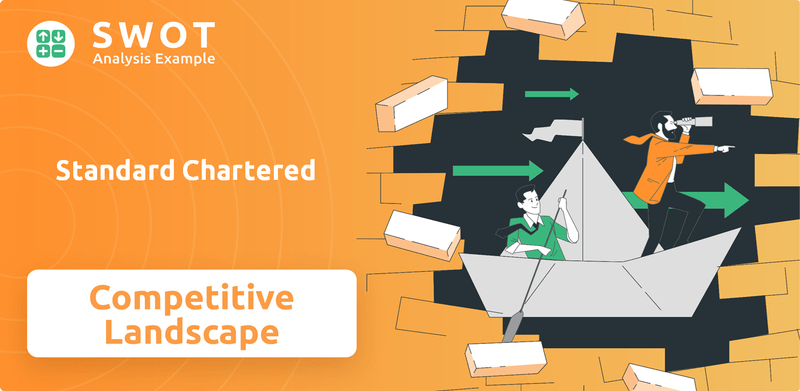
This analysis of the Standard Chartered competitive landscape will dissect its key rivals and evaluate its strategic responses to industry trends. We'll explore its Standard Chartered competitors, examine its Standard Chartered market share analysis, and assess its Standard Chartered strategy in the context of Standard Chartered financial services. Furthermore, we will look at the Standard Chartered industry to provide actionable insights for investors and business strategists alike.
Where Does Standard Chartered’ Stand in the Current Market?
Standard Chartered maintains a distinctive market position, primarily focused on emerging markets across Asia, Africa, and the Middle East. This strategic focus differentiates it from many global banks that prioritize developed economies. The bank's expansive geographic presence is evident in its network, which spans 53 markets, serving clients in 120 countries. This business model emphasizes deep-rooted relationships and expertise in high-growth regions.
The bank's core operations are structured around Corporate, Commercial & Institutional Banking (CCIB), Consumer, Private & Business Banking (CPBB), and Wealth Management. Standard Chartered is actively undergoing digital transformation, investing heavily in technology to enhance its digital offerings and improve customer experience. This strategic move reflects the broader industry trend toward digital banking, strengthening its competitive positioning.
In 2023, Standard Chartered reported a robust financial performance. The bank achieved an underlying profit before tax of $5.7 billion, an increase of 18%, and an underlying Return on Tangible Equity (ROTE) of 10.9%. This financial health is particularly notable given its strategic focus on emerging markets, which offer higher growth potential but also present unique risks. This performance is a key indicator of its competitive standing within the global banking sector.
Standard Chartered's geographic presence is a key differentiator, with a strong focus on emerging markets. The bank operates in 53 markets and serves clients in 120 countries. This extensive network allows it to capitalize on growth opportunities in high-potential regions.
The bank demonstrated strong financial performance in 2023, with an underlying profit before tax of $5.7 billion. The underlying Return on Tangible Equity (ROTE) was 10.9%, reflecting efficient capital utilization. This financial strength supports its strategic initiatives and market position.
Standard Chartered's primary product lines include Corporate, Commercial & Institutional Banking (CCIB), Consumer, Private & Business Banking (CPBB), and Wealth Management. The diverse range of services caters to a broad customer base across various segments. These offerings support its comprehensive approach to financial services.
The bank is actively investing in digital transformation to enhance customer experience and strengthen its digital offerings. This strategic move is crucial for maintaining competitiveness in the evolving financial landscape. Digital initiatives are key to future growth and market relevance.
Standard Chartered's competitive landscape is shaped by its focus on emerging markets and its diverse product offerings. The bank's strong financial performance and ongoing digital transformation initiatives further enhance its market position. The bank’s strategy is designed to leverage its geographic presence and expertise in high-growth regions.
- Strong presence in emerging markets across Asia, Africa, and the Middle East.
- Robust financial performance with increasing profits and returns.
- Ongoing digital transformation to improve customer experience and offerings.
- Diverse product lines, including CCIB, CPBB, and Wealth Management.
Standard Chartered SWOT Analysis
- Complete SWOT Breakdown
- Fully Customizable
- Editable in Excel & Word
- Professional Formatting
- Investor-Ready Format
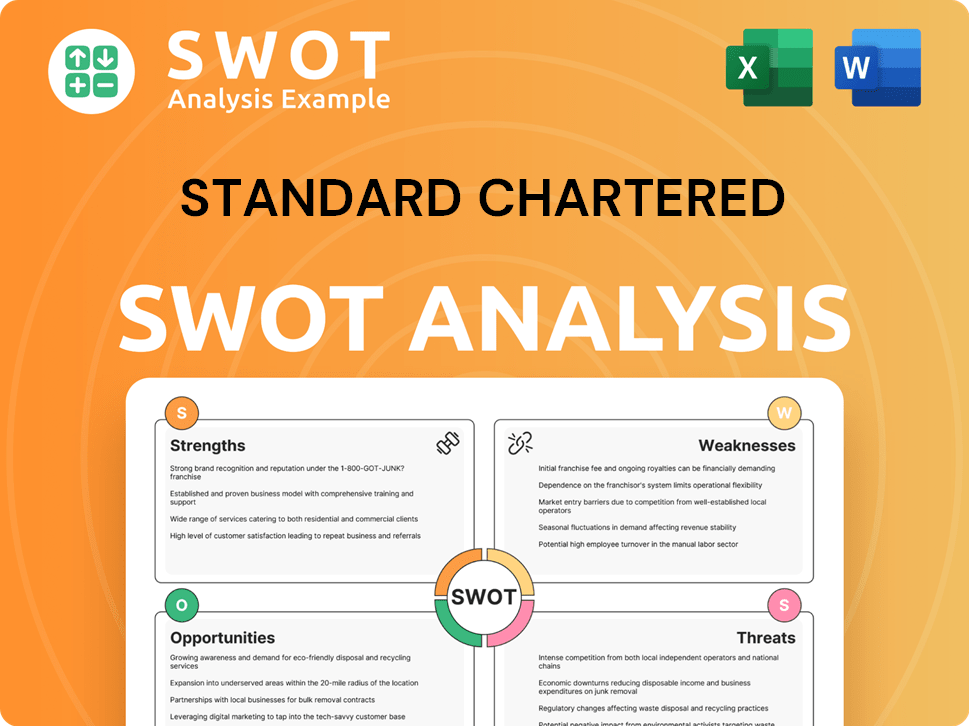
Who Are the Main Competitors Challenging Standard Chartered?
The Standard Chartered competitive landscape is shaped by a complex interplay of global and regional financial institutions. The bank's strategic focus on emerging markets places it in direct competition with major international banks and regional powerhouses. Understanding these competitors is crucial for a thorough Standard Chartered market analysis and evaluating its future prospects.
Standard Chartered's ability to maintain its market position depends on its capacity to differentiate itself through specialized services, technological innovation, and effective risk management. The Standard Chartered industry is dynamic, with constant shifts in competitive pressures, requiring the bank to adapt and innovate continuously. A detailed examination of its competitors offers insights into the challenges and opportunities the bank faces.
The bank's strategy involves navigating a competitive environment that includes both direct and indirect competitors, from global banking giants to nimble fintech companies. This section will explore the key players in the Standard Chartered competitive landscape, providing a detailed look at their strengths, weaknesses, and strategic approaches.
HSBC is a major direct competitor, sharing a similar focus on Asia and emerging markets. They compete in trade finance and corporate banking, among other areas. In 2024, HSBC reported a profit before tax of $30.3 billion, indicating its substantial presence in the global financial market.
Regional banks like DBS Bank and OCBC Bank offer strong competition in Asia, leveraging local market knowledge. These banks can often make quicker decisions and have established customer bases. DBS reported a net profit of SGD 10.3 billion in 2024, highlighting its robust performance in the region.
Fintech companies are disrupting traditional banking, especially in payments and lending. These companies use digital platforms to offer specialized services. The global fintech market is projected to reach $324 billion by 2026, showing the growing impact of fintechs.
Non-bank financial institutions, such as investment firms and insurance companies, also compete. These institutions offer financial products and services that overlap with those of traditional banks. The assets under management by non-bank financial institutions continue to grow, increasing competition.
Mergers and alliances reshape the competitive landscape, with larger entities acquiring smaller firms. The emergence of new players using blockchain and AI intensifies competition. The Standard Chartered financial services sector is constantly evolving.
Standard Chartered's geographic presence in Asia, Africa, and the Middle East is a key factor. The bank's emerging market strategy is crucial for its growth. Understanding the competitive dynamics in each region is essential for success.
To maintain a competitive edge, Standard Chartered must focus on several key areas. These include leveraging technology, expanding its digital banking services, and strengthening its risk management practices. For a detailed look at how the bank is approaching growth, see Growth Strategy of Standard Chartered.
- Digital Transformation: Investing in digital platforms and services to compete with fintechs.
- Customer Experience: Improving customer service and offering tailored financial products.
- Risk Management: Strengthening risk management to navigate economic uncertainties.
- Strategic Partnerships: Forming alliances to expand market reach and capabilities.
Standard Chartered PESTLE Analysis
- Covers All 6 PESTLE Categories
- No Research Needed – Save Hours of Work
- Built by Experts, Trusted by Consultants
- Instant Download, Ready to Use
- 100% Editable, Fully Customizable
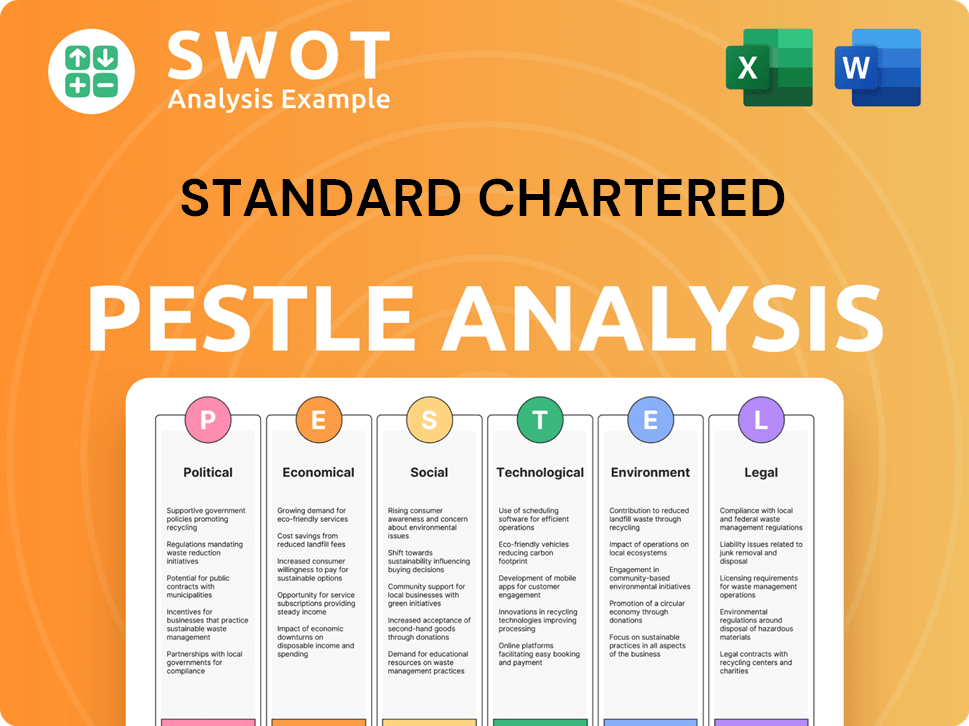
What Gives Standard Chartered a Competitive Edge Over Its Rivals?
Examining the Brief History of Standard Chartered reveals its robust competitive advantages. These strengths are rooted in its strategic focus on emerging markets and its established presence in key regions. The bank's ability to navigate complex regulatory environments and offer tailored financial solutions sets it apart in the competitive landscape.
Standard Chartered's competitive edge is further enhanced by its strong brand equity and customer loyalty. This has allowed it to build a loyal customer base, particularly among corporate and institutional clients. Its commitment to digital transformation and sustainability initiatives also positions it well for future growth. These initiatives are crucial for maintaining its relevance in a rapidly evolving financial services industry.
The bank's strategic investments in digital transformation and sustainability are vital for maintaining its competitive edge. These efforts aim to improve customer experience and operational efficiency. As of early 2024, Standard Chartered continues to invest in these areas to meet evolving customer needs and industry trends.
Standard Chartered's extensive network across 53 markets, with a strong emphasis on Asia, Africa, and the Middle East, is a key differentiator. This geographic presence allows it to understand and cater to the specific needs of these diverse economies. This deep local expertise enables the bank to offer customized financial solutions and navigate complex market dynamics effectively.
The bank's strong brand equity, built on trust and reliability, fosters significant customer loyalty. This is particularly evident among corporate, institutional, and affluent individual clients. This loyalty is crucial for maintaining a stable customer base and attracting new clients in competitive markets.
Standard Chartered’s robust trade finance franchise is a significant competitive advantage. Leveraging its extensive network, the bank facilitates international trade and investment flows. This specialized expertise is crucial for multinational corporations operating in its core markets, providing a valuable service that many competitors struggle to match.
The bank's ongoing investments in digital transformation and sustainability are key to its future competitiveness. These initiatives aim to enhance customer experience and operational efficiency. As of early 2024, Standard Chartered's commitment to green finance solutions attracts clients prioritizing ESG factors.
Standard Chartered's competitive advantages include its geographic footprint, brand reputation, trade finance expertise, and commitment to digital transformation and sustainability. These factors enable it to maintain a strong position in the financial services industry. The bank's strategic focus on emerging markets provides a foundation for sustained growth.
- Extensive network in 53 markets, particularly in Asia, Africa, and the Middle East.
- Strong brand equity and customer loyalty, especially among corporate and institutional clients.
- Robust trade finance franchise facilitating international trade and investment.
- Ongoing investments in digital transformation to improve customer experience.
- Growing focus on sustainability and green finance solutions.
Standard Chartered Business Model Canvas
- Complete 9-Block Business Model Canvas
- Effortlessly Communicate Your Business Strategy
- Investor-Ready BMC Format
- 100% Editable and Customizable
- Clear and Structured Layout
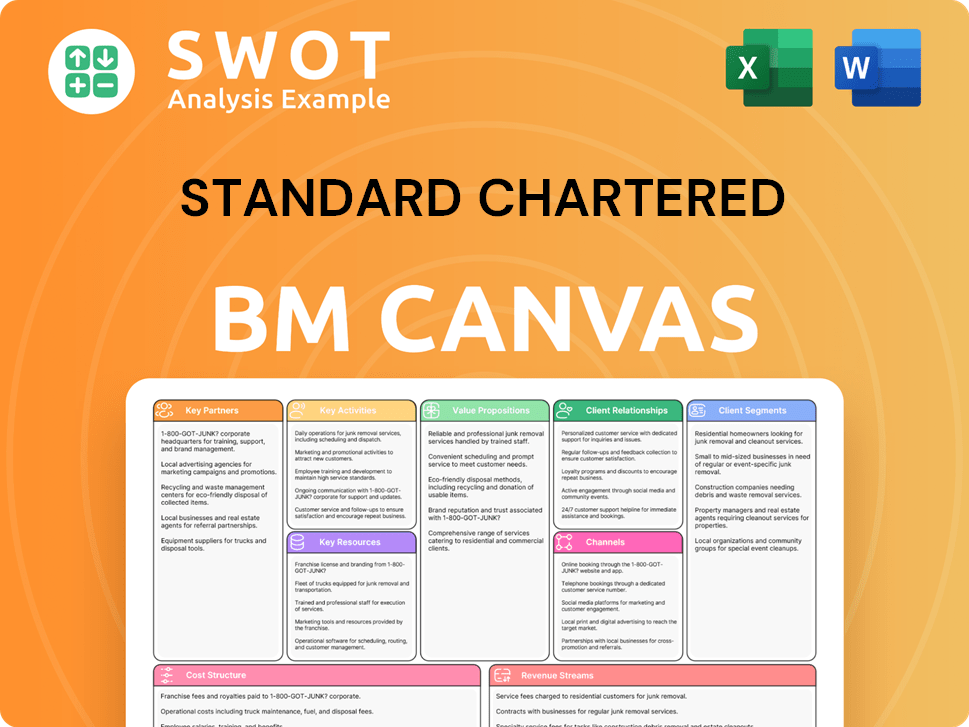
What Industry Trends Are Reshaping Standard Chartered’s Competitive Landscape?
The Standard Chartered competitive landscape is significantly shaped by the dynamic shifts within the financial services industry. The bank faces both challenges and opportunities stemming from technological advancements, regulatory changes, and evolving consumer preferences. A comprehensive Standard Chartered market analysis reveals a complex interplay of factors influencing its strategic direction and financial performance.
The bank's position is further complicated by global economic uncertainties, including inflation, interest rate fluctuations, and geopolitical tensions. These factors can impact Standard Chartered's financial performance comparison with its peers. The rise of fintech companies and increased competition from local banks also pose significant threats, necessitating continuous adaptation and innovation to maintain market share and profitability. Understanding the Standard Chartered key rivals is crucial for strategic planning.
Technological advancements, particularly in AI, blockchain, and cloud computing, are driving digital transformation. Regulatory changes, including stricter compliance requirements and evolving data privacy laws, also pose challenges. Shifting consumer preferences towards digital channels and sustainable finance options are compelling banks to innovate.
Aggressive new competitors, especially fintechs, pose a threat. Declining demand in some traditional banking segments is a concern. Increased competition from local banks in core markets presents a challenge. Global economic shifts introduce volatility.
Economic growth in Asia, Africa, and the Middle East offers a large untapped market. Expanding digital banking services and leveraging data analytics are key. Growing demand for sustainable finance and ESG-linked products presents opportunities. Strategic partnerships with fintechs can drive innovation.
Standard Chartered's strategy focuses on digital transformation, sustainable finance, and strengthening core franchises. The bank is investing heavily in technology to enhance digital services. It is expanding its green finance portfolio and seeking partnerships to drive growth. For more insights, see the Marketing Strategy of Standard Chartered.
Standard Chartered is focusing on emerging markets, leveraging its established presence in Asia, Africa, and the Middle East. The bank is expanding its digital banking capabilities to reach a wider customer base. It's also committed to sustainable finance, aiming to attract environmentally conscious clients and expand its green finance portfolio.
- Digital Transformation: Investing in technology to enhance digital services and improve operational efficiencies.
- Sustainable Finance: Expanding the green finance portfolio to meet growing demand for ESG-linked products.
- Strategic Partnerships: Collaborating with fintechs and other financial institutions to drive innovation and growth.
- Geographic Expansion: Focusing on growth in Asia, Africa, and the Middle East.
Standard Chartered Porter's Five Forces Analysis
- Covers All 5 Competitive Forces in Detail
- Structured for Consultants, Students, and Founders
- 100% Editable in Microsoft Word & Excel
- Instant Digital Download – Use Immediately
- Compatible with Mac & PC – Fully Unlocked
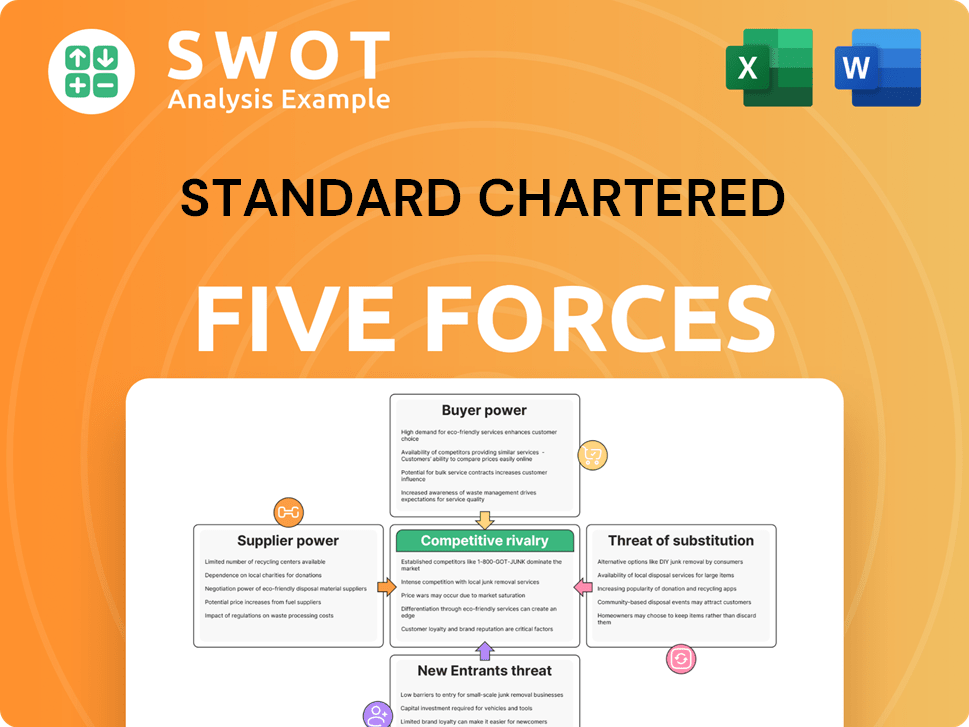
Related Blogs
- What are Mission Vision & Core Values of Standard Chartered Company?
- What is Growth Strategy and Future Prospects of Standard Chartered Company?
- How Does Standard Chartered Company Work?
- What is Sales and Marketing Strategy of Standard Chartered Company?
- What is Brief History of Standard Chartered Company?
- Who Owns Standard Chartered Company?
- What is Customer Demographics and Target Market of Standard Chartered Company?
Disclaimer
All information, articles, and product details provided on this website are for general informational and educational purposes only. We do not claim any ownership over, nor do we intend to infringe upon, any trademarks, copyrights, logos, brand names, or other intellectual property mentioned or depicted on this site. Such intellectual property remains the property of its respective owners, and any references here are made solely for identification or informational purposes, without implying any affiliation, endorsement, or partnership.
We make no representations or warranties, express or implied, regarding the accuracy, completeness, or suitability of any content or products presented. Nothing on this website should be construed as legal, tax, investment, financial, medical, or other professional advice. In addition, no part of this site—including articles or product references—constitutes a solicitation, recommendation, endorsement, advertisement, or offer to buy or sell any securities, franchises, or other financial instruments, particularly in jurisdictions where such activity would be unlawful.
All content is of a general nature and may not address the specific circumstances of any individual or entity. It is not a substitute for professional advice or services. Any actions you take based on the information provided here are strictly at your own risk. You accept full responsibility for any decisions or outcomes arising from your use of this website and agree to release us from any liability in connection with your use of, or reliance upon, the content or products found herein.